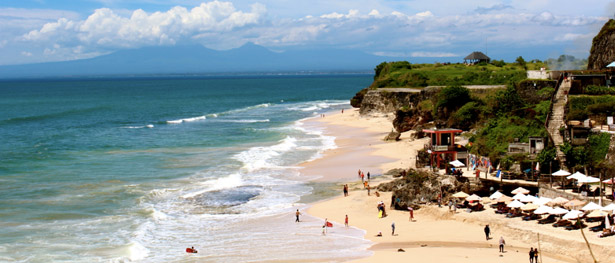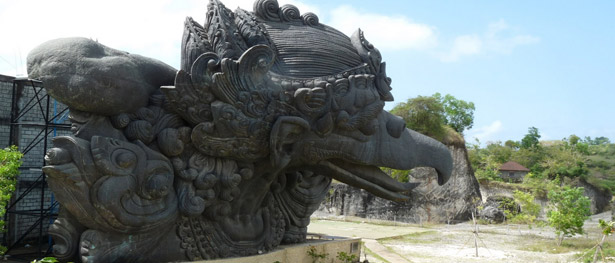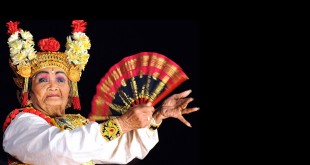Bali’s southern karst hills at first were merely hot and arid places. But the waves of tourism swept across the land and transformed its appeal.
Bali’s southern ‘Bukit’ hills are more known by the names of each of its areas. The northern part is Jimbaran, next to it is Pecatu, to the middle east is Ungasan. Geologically they are almost the same. Plants that can thrive there are shrubs and bushes and various typical plants of arid areas. At first the karst hills were merely hot and arid places, but then the waves of tourism swept across the land and transformed its appeal. Now everyone wants a slice of the limestone.
Karst
The Bukit has a long history. Based on research conducted by Bali’s Udayana University, the hilly karst area was formed from coral sedimentation followed by morphing stages at the end of the Miocene to the early Pliocene period, around 10 million years ago.
The existence of karst formations had formed many rock shelters and caves in this southern hilly region, such as those most known in the Jimbaran area. Beside sinkholes and cavities, this karst region also has many underground waterways. This is one of the factors that cause the seeming absence of surface water, due to the seeping into underground voids and impacting surface reservoirs. The barrenness is characteristic of karst areas.

The People
The majority of the people make their livelihood from farming, but they don’t tend rice fields. They process the land by planting corn, peanuts, sweet potatoes and various other roots such as cassava. Communities raise cattle, pigs and poultry. Although the hills are surrounded by sea, according to statistical data not many of the people are fishermen.
The average income is not high. There aren’t many schools in the region. People carry on living how their parents lived, from generation to generation. Then through time, other new jobs came along, such as being surf guides. Most of the locals have learned how to surf since elementary school. The boys went to the beach and learned to surf from foreigners, who also lent them their surfboards. At first it was merely a pastime, but later on they could realize their dreams and become professional surfers.
The Surfers
A source says that surfing in Bali was started by Californian Bob Koke and his wife who arrived around 1936. Later in the 60s, other foreign surfers such as Gerry Lopez and living legend Kim Bradley came along. Kim Bradley is an Australian surfer who has a design workshop and can easily be found in Kuta.
Bali and the Bukit are a paradise for surfers. And that is for several reasons, warm water and relatively uncrowded breaks when compared to other waves abroad. Bali gets the same kind of surf almost all year round, and there are beach breaks like Dreamland and also reef breaks on the rest of the Bukit, including the famous Uluwatu.
From April to October the trade winds favor surfing on the western side of the coast, including the breaks on the western Bukit like Uluwatu and Bingin. During November to March the tides and winds favor the eastern coast including the eastern Bukit breaks such as Nusa Dua and the one dubbed ‘Sri Lanka’.
It is no doubt that the advent of surfers influenced life in the Bukit. Previously, outsiders came to the Bukit only to pray at the Uluwatu Temple. This temple is one of the largest and most important temples in Bali. Now people come to enjoy the beauty of the beaches, not only for surfing but also to just relax and enjoy the beautiful beaches such as Dreamlands.
The arriving surfers made several changes. They needed home stays in which to reside, warungs in order to get meals, massages in order to relax, and souvenirs to keep their memories alive. The locals certainly try to provide all their needs. If you go to the Suluban coast, you can find warung stands one after the other. Local women offer massage services or bring bunches of souvenirs, waiting for the surfers to finish surfing.
The Tourism
Slowly but surely the allure of the hilly south began to spread and attract investors. Large hotels of various names began to emerge, such as the Bali Cliff, Bvlgari, Ritz-Carlton, Four Seasons and many others. Investors not only built hotels but also residences and personal villas. In many of Bali’s popular advertising media, you can easily find land on offer in the Bukit region.
A prestigious project also in the Bukit area is the Garuda Wisnu Kencana (GWK) Park. Currently it is at a construction standstill, yet according to plan, it will become the cultural park with a 145m high Wisnu statue, higher than the Statue of Liberty. Though unfinished, it is frequently used for various national and international events such as the first Asian Beach Games’ grand opening ceremony last month, opened by the Indonesian president.
The most ambitious project was the Bali Pecatu Graha (BPG) which began in 1994. This project belonged to ‘Tommy’ Soeharto, the former Indonesian President’s son. The plan was to build Indonesia’s largest fully integrated resort development on over 400 hectares of land. The latter development includes various facilities including the international 18-hole New Kuta Golf & Ocean View course.
Unfortunately this project had many land ownership problems, an issue that always followed a process of development it seems. Land owners were merely like specks of dust to billionaire investors.
In the Future
This barren karst area now has become a blossoming hill. At night if you sit on Jimbaran beach you can easily see the flickering of hotel lights illustrating the beauty of the skyline. Almost every house has electricity. Water access is also better than in years before.
The development of the Bukit is still ongoing. While old projects are still in progress, new projects are also coming up, such as the 176- room Outrigger Panorama Bali Resort that is planned to open around 2010.
Unfortunately, the development leap is not accompanied by a significant change in the people’s livelihood. Over the infertile land cattle still graze freely. Small children carry grass feed on their shoulders, people who have ‘lost’ their land stay separately from their families. Some of them need to walk through the golf greens just to pray at their family temples. They enjoy the slice of the tourism cake indeed, but only a small portion of it.
Text by Ni Luh Dian PurniawatiArticle Source : baliandbeyond.co.id





